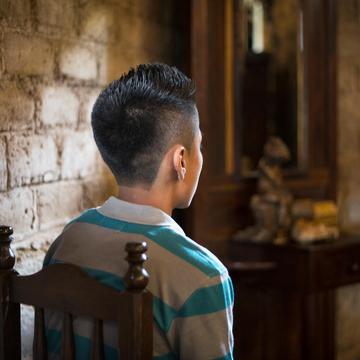
Tragically, 29% of all child homicides occur in in Latin America and the Caribbean. The threat of violence can lead to chronic stress in children, especially in children who have suffered the loss of a loved one. Mauricio*, pictured here, no longer attends his school because other gang members also attend. Photo credit: Tom Pilston/Save the Children, May 2017.
A Young Life Deeply Saddened by Violence in El Salvador
The world’s highest child homicide rates are found in Latin America and the Caribbean, where, shockingly, nearly 70 children die every day due to interpersonal violence. Only 9% of the world’s children live in the region, but 29% of all child homicides occur there – nearly 25,000 victims each year.[i]
This homicide rate is over three times the global average. Four of the five countries with the highest child homicide rates in the world are located in the region –��Venezuela, Colombia, Honduras and El Salvador. For years, this crisis of violence and brutal gangs combined with the complexities of entrenched poverty has driven children and families to flee and seek safety and protection in the United States. For those families and children who stay, the threat and reminder of violence can lead to chronic stress.
Thirteen-year-old Juan* lost his cousin to gang violence just over a year ago. "He was like my brother," says Juan. "It brings me misery and a feeling I cannot express, to know that from one day to the next, he's not here.
"I came home and found another cousin and my brother crying and I had a strange feeling, my mind was racing. I asked my cousin what was going on and she did not answer, she only cried. My cousin told me, 'They killed him.' I felt that my heart was crushed very badly, in the cruelest way. I began to remember many times spent with him. I couldn't believe that it had only been a few hours since I had last seen him alive. That day I sat alone, far away, in a place that only I know.
"I had never known this pain. Sometimes I would see in the news that someone was killed – that's normal these days. I hope I'm forgiven for saying this, but that's the cruel joke, that every day there are dead people –young people disappear or they kill them.
"I have dreamed of him three times. He hugs me in the dream and tells me that he will always be with me. He arranges a suitcase, takes a bath, and tells me that he is going on a long journey from which he will not return. I woke up from that dream and felt I wanted to share my sorrows. I decided I would never self-harm like others do when they have problems, because I think it's not good."
Juan believes he will never fully recover from the psychological impact of his cousin's death, but by participating in ��ɫ��Ƶart therapy and youth development programs he has found help in processing his feelings and finding hope for the future.
"The teacher makes us relax, tells us to feel the wind and imagine a cloud touching our skin. We painted there too. I drew two masks. One laughing and one crying. I explained that I've had to laugh and I am funny, but I have also cried. With my happiness, I hide my sadness."
Suffering violence, witnessing violence or fearing violence should not be part of growing up. And yet far too often, for the children of El Salvador, a country with one of the world’s highest rates of violence and homicide, it tragically is.
In communities where gang activity is prevalent, fear of gangs can prevent students from going to school and young people from holding jobs. According to one report, nearly 40,000 children in El Salvador dropped out of school in 2015, primarily out of concern for their own safety.[ii]
��ɫ��Ƶhas been present in El Salvador since 1979. Our programs focusing on health and nutrition, basic education, early childhood care and development (ECCD), protection, livelihoods and disaster risk reduction have been implemented some of the poorest areas of the country.
*Name changed to protect identity
��
[i] 2019 Global Childhood Report: Changing Lives in Our Lifetime
[ii] 2019 Global Childhood Report: Changing Lives in Our Lifetime
